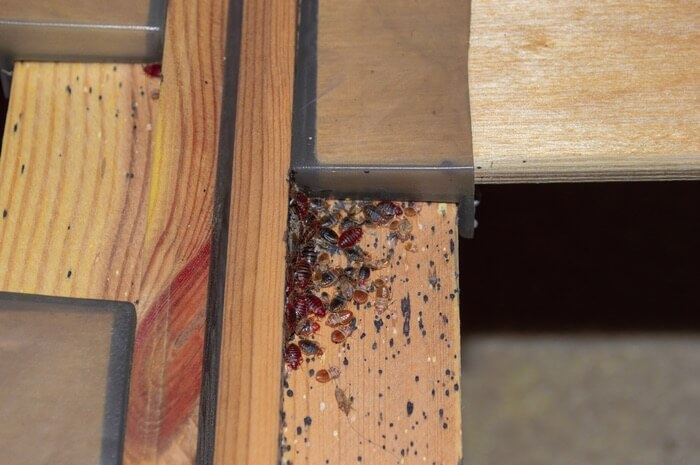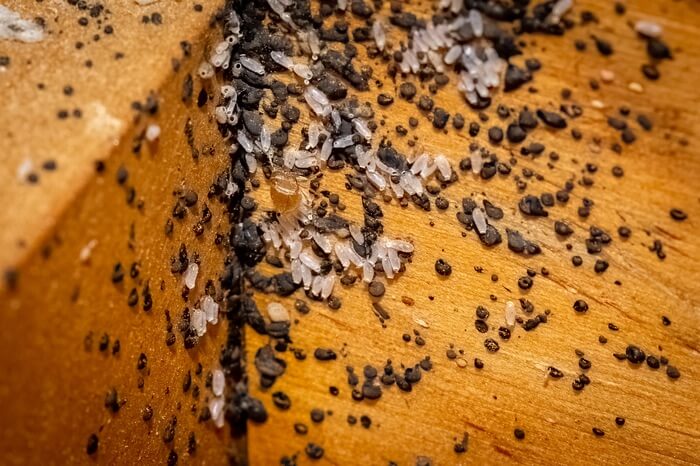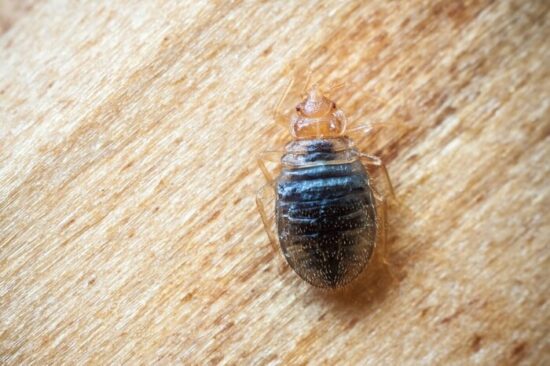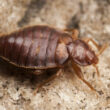Removing bed bugs from wood furniture is not an easy task. These tiny insects don’t need much space to hide and live comfortably, so you need to know the right course of action if you expect to see success.
This guide will cover if bed bugs can live in wood comfortably, and how you can get rid of them.
Table of contents
Can Bed Bugs Live In Wood?
Bed bugs aren’t fussy as to what type of surface they choose for a home. No matter what kind of material you’re dealing with, bed bugs are satisfied as long as there’s a place for them to hide.
That means bed bugs can hide and live in wood.
Although bed bugs can’t eat their way into wood like some other pests, these insects (that are not very big) will hide in any cracks, grooves or crevices in wood that they can find. These openings are usually the result of scratches, chips, wear, or burrowing by other insects. Because bed bugs are dark in color, they tend to be attracted to wood that’s a similar dark red, brown or black.
- Kill bed bugs and bed bug eggs
- Use spray as a spot treatment around bed frames, mattress seams/tufts/folds, and baseboards
- Kills even the toughest bed bugs
- The continuous spray Comfort Wand easily gets into hard-to-reach areas
Bed bugs tend to prefer natural wood over wood that’s been engineered. Natural wood is an organic material that expands and contracts with variations in temperature and humidity. With time, it wears, scratches and chips, creating the cracks, crevices and gaps that attract bed bugs. In addition, termites and other burrowing insects will often inadvertently create some ideal hiding spots for bed bugs in wood.

If you plan to put in a new floor and are concerned about the potential for a bed bug infestation, the worst possible choice of flooring is a wood floor (especially hardwood). Wood floors are known for their many cracks, knotholes, joints, and other imperfections. This makes them excellent hiding spots for bed bugs.
Bed bugs can also live in wood furniture just as they can live in metal furniture or furniture that’s made of any other material. However, wood furniture tends to offer more places where they can live and hide (such as cracks and gaps). For this reason, bed bugs might choose wood furniture over that composed of other materials.
Unfortunately, some of our most favorite pieces of wooden bedroom furniture can be especially appealing to bed bugs. Because they often feature intricately-engraved designs or small cracks or crevices, early American, traditional or colonial chests, dressers, vanities, nightstands, desks, bookcases and shelves provide the perfect hiding environment for bed bugs. Modern-style metal furniture is often smoother and offers fewer hiding places for the pesky insects.
Quick Tip: Your great-grandmother’s antique wood dresser may be a priceless family heirloom, but its intricately-engraved drawers can provide a haven of dark, hidden areas for bed bugs to live and hide. Antique wood bed frames and headboards offer attractive hiding places as well. However, these are even more attractive to these insects because they’re so close to the bed (and your delectable blood).
Signs Of Bed Bugs In Wood Furniture
Because bed bugs can live in wood furniture that has the tiniest cracks and crevices, you’ll probably not notice their presence unless you first disassemble each piece. That means you’ll need to carefully inspect each door, drawer and shelf, concentrating on areas in the hinges and joints.
Here are some signs there may be bed bugs living in your wood furniture.
Live Bugs
An obvious sign that you have bed bugs living in your wood furniture is seeing them firsthand. These insects are oval-shaped, a dark reddish-brown color, and have six legs. The bed bug’s antennae are short, and if they haven’t fed in a while they’ll appear flat and lighter in color.
Tiny Eggs
The presence of eggs is another telltale sign that you have bugs hiding inside some of your wood furniture. These eggs are very small and are a clearish white.
Shed Exoskeletons
Bed bugs will molt (or shed), so exoskeleton casings are another calling card that these pests are lurking. The molted casings are small, oval shaped, and a transparent pale brown in color.
Droppings
Bed bug droppings are red, dark brown or black smears that resemble ink spots. Depending on whether or not the wood is varnished, the spots may appear either flat or a little raised.
A Pungent Or Musty Smell
Not every piece of affected wood furniture will have a visible sign of an infestation. Instead, a large enough infestation can end up causing quite the stink!
Quick Tip: Some people describe the odor as similar to that of rotting berries.
Peeled Paint
Remember, bed bugs look for the best place to hide, and that could even be under paint that’s been peeled away. Depending on the kind of wood we’re dealing with, there could be quite a bit of peeled paint for them to live in.
How To Remove Bed Bugs From Wood Furniture
You may have heard about some of the natural home remedies such as baking soda, cayenne pepper, ginger, and various other scents that keep bed bugs away. While these methods can help you remove bed bugs from wood furniture, they’re not as effective as some other options.
- Kill bed bugs and bed bug eggs
- Use spray as a spot treatment around bed frames, mattress seams/tufts/folds, and baseboards
- Kills even the toughest bed bugs
- The continuous spray Comfort Wand easily gets into hard-to-reach areas
Some suggest that if you apply a new coat of varnish to your wood furniture, the bed bugs will die. This is another myth for which there is no evidence to prove its credibility.
However, there are plenty of effective ways to get rid of bed bugs that are living in your wood furniture. Here are some that we recommend.
1. Insecticides
Although insecticides are effective killing agents, it’s sometimes difficult to get the product applied into the tiny cracks and crevices in wood where bed bugs hide. You may have to completely saturate the furniture to ensure that the insecticide actually reaches the bugs.
Quick Tip: Because these chemicals are so widely used, some bed bugs have adapted a genetic resistance to them. It’s unlikely that you’ll be thwarted by this, but it’s worth pointing out.
Insecticides that are chemical based will immediately kill bugs on contact. Most are liquid and pyrethroid based. If you’re concerned about the safety of using insecticides around children or pets, you might prefer to use natural essential oil-based products. However, these types of insecticides have not proven to be effective.
Desiccants work by slowly dehydrating the insects. Diatomaceous earth is one such insecticide that’s used all the time. One advantage of desiccants is that the insects won’t develop a resistance to the product. Oh the other hand, a disadvantage is that because they’re usually only available as powders, they’re more difficult to work with or to effectively apply.
2. Steam Cleaning
By reaching every corner, crack, crevice, and gap in wood, a steam cleaner can effectively scald bed bugs and their eggs. A commercial-grade cleaner that reaches temperatures of between 122 and 160 degrees Fahrenheit is much more effective than a carpet cleaner that may not reach hot enough temperatures to do the trick.
Steam cleaning is the most effective method of removing bed bugs in wood furniture, but you’ll need to be cautious. The high heat and excess moisture may cause wood furniture to warp or bend.
3. Toss The Infested Piece Of Furniture.
If the infested wood furniture is large and full of cracks, gaps or crevices, your safest option is simply to toss it. This is especially true if a steamer can’t effectively clean into the tiny grooves or holes. As disappointing as it might be, removing the piece to avoid further infestation is one of the most effective methods to stop these insects from spreading (which they can do very fast).
4. Hire A professional exterminator.
If you’ve tried all the do-it-yourself methods, still can’t remove the bed bugs, and aren’t yet ready to give up your special piece of wood furniture, you can have a professional pest control specialist tackle the job.
A professional exterminator will thoroughly inspect your entire home for any places where bed bugs may tend to hide (not just in wood). After a lengthy inspection, the exterminator will decide which method, type of insecticides, and types of equipment can best do the job to effectively remove the bed bugs from your wood furniture.
Following the treatment, which may require several visits, the pest control specialist will recommend any future action you can take to prevent further infestation. Always be sure that they provide you with a warranty to ensure you’re covered in the unlikely event the treatment is unsuccessful.
How To Prevent This From Happening Again
The best way to prevent future bed bug infestations is to not allow them into your home in the first place. That means you need to be cautious when choosing any wood furniture you want to bring into your home, especially used furniture. Avoid yard sales, and never pick up furniture that’s been placed curbside. You never know why the owner tossed it, and it may have been put there because it was already infested with bed bugs!

Also, avoid purchasing used wood furniture online. Whether it’s intentional or unintentional, the seller might be sending a bed bug-infested piece to your home. Even if you purchase a piece of furniture from a reputable antique dealer, avoid having them deliver it and opt to take it home yourself.
If you do decide to purchase used wood furniture (even from a reputable thrift store or someone you know), thoroughly inspect it with a flashlight and a magnifying glass before loading it into your vehicle. Your car doesn’t need a bed bug infestation any more than your home does!
Quick Tip: You’re no doubt familiar with the method pet parents use to check for fleas. They place a piece of white paper next to the animal and comb through the pet’s hair. If dark specks fall on the paper and turn a reddish brown when moistened, that means the pet has fleas.
Similarly, you can place a white sheet of paper under or near the wood furniture you plan to purchase and use a tool such as a knife, a spatula or an expired plastic card to run along the joints and crevices. If bed bugs are hiding in the wood, some are sure to fall on the white paper.
If the seller objects to your inspection, don’t go through with the sale! It’s better to create bad feelings than to bring a bed bug infestation into your home. No matter whether it’s used or even new, carefully inspect any piece of wood furniture before you consider bringing it into your home. Remove any drawers, disassemble any piece when possible and thoroughly clean each piece.
If you’ve already had bed bugs living in wood, the way to prevent them from invading your home in the future is to first treat the existing problem. This can either be with your own remedy or through a professional pest control service.
Then, caulk any large areas to seal off potential entry points. Make sure you evenly caulk every crack, crevice, hole and groove. Even the bed bugs that may have entered won’t be able to exit and won’t live much longer under these conditions. You can also fill small cracks with diatomaceous earth to kill these insects.
Common Questions
You may be curious as to how bed bugs interact with wood. Here are some answers to questions we get all the time.
Are Bed Bugs Attracted To Wood?
Although bed bugs aren’t particular as to what type of material they choose to live in, they look for safe hiding places where they can lay their eggs. In other words, bed bugs are attracted to the habitat wood can provide (not the wood itself).
Wood offers them such places in the form of plenty of cracks, gaps, crevices and grooves. They also want the place to be near a food source (even though they can survive for a while without feeding). This source of food is primarily going to your blood, and that’s why bed bugs tend to live in living rooms and bedrooms, especially in beds and couches.
Quick Tip: The added bonus that these pieces of wood furniture offer is that the bed bugs’ hosts use them for rest, relaxation, and sleep. That means their meal comes to them, and will be available for long periods of time!
Do Bed Bugs Lay Their Eggs In Wood?
Bed bugs choose to lay their eggs in secure and dark areas. Many cracks, crevices, holes, and knots in wood are ideal places for them to do this. Because they prefer to be near their hosts, they’ll prefer to seek out gaps in floorboards, spaces behind baseboards or even your bedroom hardwood floor.
A female bed bug can lay as many as three eggs every day, which amounts to between 200 and 250 eggs during her lifespan. In fact, a bed bug population can double in less than two weeks! Needless to say, bed bugs can quickly infest a piece of wood furniture or even an entire home.
Do Bed Bugs Eat Wood?
The answer to this question is a simple “no.” Bed bugs do not eat wood.
These insects eat only one thing, and that’s blood. This is preferably human blood, although they may feed on your pets or any other warm-blooded animal if they’re desperately hungry (it’s quite rare though). Some species are even partial to bats’ blood!
Blood is essential for every stage of the insect’s development. Bed bugs sense their food source through their host’s heat and carbon dioxide emissions.
Wrapping Up
As you can see, bed bugs can live and hide in wood without any issues. That means you need to have a bit of knowledge if you want to deal with them properly.
However, now that you know how to remove bed bugs from wood furniture this shouldn’t be nearly as challenging! While these pests are frustrating, you always have options.



